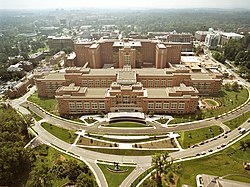NIH

National Institutes of Health logo
|
|
 Aerial photo of the NIH Mark O. Hatfield Clinical Research Center, Bethesda, Maryland |
|
| Agency overview | |
|---|---|
| Formed | 1887 |
| Preceding agency |
|
| Headquarters | Bethesda, Maryland, U.S. |
| Employees | 20,262 |
| Annual budget | US$30.9bn (as of 2010[update]) |
| Agency executive |
|
| Parent agency | Department of Health & Human Services |
| Child agencies | |
| Website | www.nih.gov |
The National Institutes of Health (NIH) is a biomedical research facility primarily located in Bethesda, Maryland. An agency of the United States Department of Health and Human Services, it is the primary agency of the United States government responsible for biomedical and health-related research. The NIH both conducts its own scientific research through its Intramural Research Program (IRP) and provides major biomedical research funding to non-NIH research facilities through its Extramural Research Program.
With 1,200 principal investigators and more than 4,000 postdoctoral fellows in basic, translational, and clinical research, the IRP is the largest biomedical research institution in the world, while, as of 2003, the extramural arm provided 28% of biomedical research funding spent annually in the U.S., or about US$26.4 billion.
The NIH comprises 27 separate institutes and centers that conduct research in different disciplines of biomedical science. The IRP is responsible for many scientific accomplishments, including the discovery of fluoride to prevent tooth decay, the use of lithium to manage bipolar disorder, and the creation of vaccines against hepatitis, Haemophilus influenzae (HIB), and human papillomavirus (HPV).
NIH's roots extend back to a Marine Hospital Service in the late 1790s that provided medical relief to sick and disabled men in the U.S. Navy. By 1870, a network of marine hospitals had developed and was placed under the charge of a medical officer within the Bureau of the Treasury Department. In the late 1870s, Congress allocated funds to investigate the causes of epidemics like cholera and yellow fever, and it created the National Board of Health, making medical research an official government initiative.
In 1887 a laboratory for the study of bacteria, the Hygienic Laboratory, was established at the Marine Hospital in New York. In the early 1900s, Congress began appropriating funds for the Marine Hospital Service. By 1922, this organization changed its name to Public Health Services and established a Special Cancer Investigations laboratory at Harvard Medical School. This marked the beginning of a partnership with universities. In 1930, the Hygienic Laboratory was re-designated as the National Institute of Health by the Ransdell Act and was given $750,000 to construct two NIH buildings. Over the next few decades, Congress would increase its funding tremendously to the NIH, and various institutes and centers within the NIH were created for specific research programs. In 1944, the Public Health Service Act was approved, and National Cancer Institute became a division of NIH. In 1948, the name changed from National Institute of Health to National Institutes of Health.
...
Wikipedia
